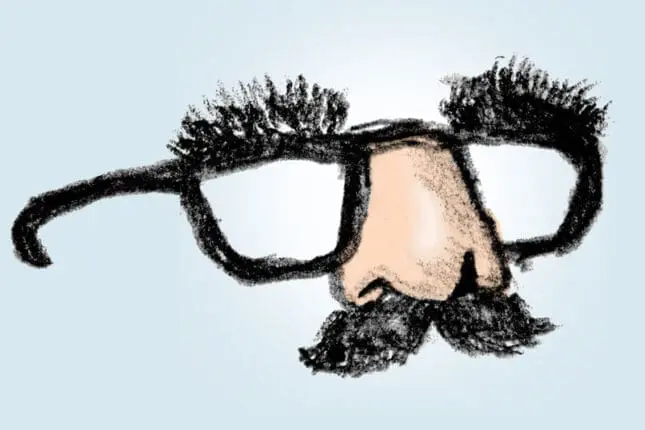From Our Archives
Laughing has serious effects: it lowers cortisol levels, rachets up our immunity and endorphins, and makes us feel connected to the world. So incorporating humor into clinical practice seems like a no-brainer. But for therapists who weren’t offered a Comedy 101 class in their graduate or licensure programs, the idea of using playful strategies with clients may feel at best transgressive, and at worst, dangerous.
Can we really be lighthearted in sessions while giving clients a felt experience of being deeply heard and understood? What if we tell a joke that falls flat? Will awkwardness envelop the session or even destroy the therapeutic alliance?
These aren’t new questions for experienced clinicians. In this collection from the Psychotherapy Networker archives, master therapists share how they’ve managed to incorporate humor into sessions in ways that both enliven and enrich the work.
***
Turning Tragedy into Comedy
November/December 1995
By Frank Pittman
Psychoanalysis, despite Freud’s most optimistic intentions, was mired in an air of tragedy, conducted in an atmosphere of shame-based privacy. The stereotypical psychoanalytic therapist would sit still and silent, and avoid contaminating the 50 minutes of self-pity with another human point of view. The psychoanalytic posture became a joke to everyone except the analyst and the patient.
Family therapy is inherently able to offer a more comic perspective. In it, the emotional corners into which people have painted themselves can become the stuff of comedy. In my therapy, I don’t eschew laughter, but the patients have most of the funny lines.
A father, berating his son, looked at me and puzzled, “I don’t know what that boy’s mother did wrong. It couldn’t have been anything I did: I was hardly ever there.” I laughed, the mother laughed, the boy laughed, and finally even the father could see his own absurdity.
Another father had been deserted by his parents and raised in an orphanage. His wife complained that he wasn’t sufficiently loving to their son. He pouted, “How can you expect me to be loving when I’ve never been loved? The only people who even tried either gave up or pissed me off.” I laughed. Once he could see the absurdity of his lifelong pout, he started connecting with the people around him, learning that he was no different from anyone else.
It’s quite impossible to move from the tragic posture to the comic until people recognize their absurdity. When people put their feelings into words, they can often see the absurdity. But sometimes they can’t see it until someone laughs at them lovingly and acceptingly. The laughter is the breath of life, the exclamation that you’ve discovered an alternative to death and despair.
Soft Shock Therapy
March/April 2014
By Cloé Madanes
Tragedy and humor are closely interconnected. Freud is noted to have said there’s no such thing as a joke, meaning that humor is the way humans deal with the saddest, most tragic circumstances of life. By using humor to help clients reconstruct their problems—almost make parodies of their own dilemmas—I help them acquire a healing distance from their woes, learn to take themselves less seriously, and gain more perspective about themselves, even more wisdom.
Following a technique used by stand-up comedians, therapists can set up a serious, even solemn atmosphere and then give an unexpected, humorous directive. One of the ways I use this technique in therapy is with husbands who get lost talking constantly about unpleasant matters.
In an effort to explain how important it is to contain these unpleasant conversations, I ask the couple to decide on a day and time, once a week, when they’ll meet in a public place for lunch—it needs to be public so the couple doesn’t start screaming at each other—and tell them that these issues won’t be discussed at any other time, unless it’s a dire emergency.
Then it’s time for the punch line.
If one of them begins to discuss these matters outside of the special meeting, the other should begin to take off their clothes. No matter where they are, they can continue undressing for as long as the other continues to talk about the issues, even if it means ending up naked in public.
This works to break the pattern of negative interactions and turns them into playful exchanges. Humor involves outrageous behavior, and so can therapy. Plus, I don’t think I’ve ever had a client who had to remove more than three or four items of clothing.
Breaking the Spell
May/June 2013
By Steve Andreas
Salvador Minuchin once began a session with a family in which a 10-year-old boy was sniffing gasoline by saying, “I understand you like to sniff gasoline. What do you think you are, an automobile?” The whole family relaxed a little at this joking recategorization, and the serious problem became a bit less serious and easier to resolve.
Minuchin went on to say, “Which do you prefer: unleaded or regular?” amplifying his view of this behavior as resulting from the boy’s preferences. Minuchin next took a sip of the herbal tea he’d been holding, smelled it, and said, “I wonder what kind of tea this is?” He turned to the boy, held out his cup, and said, “Since you have a good nose, tell me what kind of tea this is.”
Jokes are useful for much more than changing emotional states. They elicit the neurology that’s involved in a change of perspective and meaning. Every joke or cartoon has a setup that creates an ordinary and easily understood conventional narrative with a conventional meaning. Then the punch line completely changes this, and our response is to smile or laugh as we embrace a new—and usually unexpected—perspective and meaning.
My current favorite setup line is, “What would you like people to say about you at your funeral?” Most of us immediately begin to consider the possible compliments we’d most like to have said of us: “She was sensitive and empathic, and contributed new ideas to the field.” Once we’ve gotten involved in composing our eulogies, the punch line to the joke’s question—“Look! He’s moving!”—takes us by surprise and makes us laugh, not only at the joke, but also at our own vanity.
Every joke, and most other kinds of humor, involve some kind of shift in perspective that changes your internal images. This is the same kind of change in neurology and understanding that occurs when someone takes even a small step toward resolving a problem. The experiential patterns of humor are exactly the same as the patterns of reframing, in which the meaning of an event pivots and shifts instantaneously.
Even when the content of a joke has nothing whatsoever to do with a client’s problem, it shifts his or her mental state into one that’s more playful and flexible, open to seeing the problem in a new way.
How Conversation Sparks Therapeutic Change
September/October 2012
By Ron Taffel
Almost nothing can boost a client’s confidence more than cracking up—and I’m not talking about a DSM diagnosis. As long as we understand a client’s sensitivities, laughs can’t help but find their way into engaging conversation.
Harold was a thirty-something, deadpan kind of a guy who suffered from complex childhood traumas, which created severe anxiety attacks. After the initial phases of treatment, he said he couldn’t bring himself to tell me something extremely important for fear of being derided. I asked, “Well, how about if you and I both put on a pair of Groucho glasses, and you can tell this secret more ‘anonymously’?”
Harold agree, and at the exact same instant we were sitting there in our “disguises,” finally discussing Harold’s (quite ordinary) concern, two painters on a scaffold descended and stopped right outside the window. They started pointing at us, laughing with great zest and, I do believe, derision. Harold’s paranoid fantasy had become a reality, only now we were both rolling on the floor, hysterical ourselves.
After we two Grouchos vigorously gesticulated at the painters, Harold suddenly began talking about how he’d always had the ability to make people feel cheerful. He recovered his unspoken and competent lighter self, and his contagious good humor slowly became a central part of the way he thought of himself in the world, influencing his choice of a marriage partner, how he dealt with the multiple sclerosis that later developed, and his career decision—to become a therapist.
Creating Adventure and Play in Therapy
July/August 2013
By Courtney Armstrong
Michael is a good example of a client who responded positively to my being more playful in our sessions. We’d been working together for a while on his struggles with alcoholism and a debilitating phobia of driving over bridges. Unfortunately, this phobia had shrunk his world, since our town is nicknamed Bridge City.
Michael often wore a mask of arrogance and loved to distract me with sarcastic comments anytime we got close to exploring his inner terror and pain. One day, he started by saying, “Ah, I see you’re wearing new boots today. Is that what you do with the money from our sessions? Or are you wearing those because you think you’re going to kick my butt today with some psycho mumbo jumbo?”
I laughed and replied, “Yeah. I’ve got a challenge for you. I know you want to test me to see if I know what I’m doing and if this therapy thing has been worth your money. I think you’re ready to cross a few small bridges on foot between now and our next session. You can start out with the little footbridge that crosses the creek in the park a couple of blocks from my office. I’ll even meet you there in my kick-ass boots, if you like.”
He laughed and said in a mocking voice, “No, Miss Courtney, I don’t need you to hold my hand. I can do it all by my wittle self.”
Then I teased him and said, “I know you can do it, but I bet you won’t.”
“I’ll bet I will,” he responded, smiling. “I’ll take a picture on my phone to prove it to you, Miss Smarty Pants.”
I shook my head. “I don’t believe it. I bet you $50 you won’t do it.”
“You’re on, lady,” he said, shaking his fist at me. “If I do it, you’ll give me $50 off this session?”
I nodded and said, “Yes, sir, I will. But I don’t have to worry about it because you’re so stubborn I know you won’t do it.”
He leapt from the sofa. “Well, I’ll go do it right now and show you! I want my $50!”
With that he drove right over to the park, marched across the bridge, and texted me a picture of him standing on the other side with his tongue sticking out.
He returned to my office within 25 minutes, grinning from ear to ear. As he reached out to take the money, his hands were trembling and his face was flushed. He gave me a brief hug and began to cry. “Thank you,” he said. “You got me all caught up in that. It’s just now hitting me what I did. I really did it! I can do this.”
I smiled, and said, “Yes, Michael, you absolutely can. We just had to find something more emotionally compelling than your fear to get you to take a risk.”
It isn’t enough to be a kind, supportive guide on clients’ journeys. To get the emotional brain to pay attention to what we’re saying, the therapy experience has to be at least twice as interesting as the problem.
Taming the Wild Things
January/February 2013
By Lynn Lyons
The little-known secret about anxiety—which it works hard not to reveal—is that it can’t stand being laughed at. So I spend much of my time being a comedian, getting kids and parents to see how silly and puny this monster is. Humor and creativity allow us, as Jay Haley said, “to change the framework of the situation in the spirit of play.”
Early on, I give families a lesson in how worry hijacks the brain. With a big dry erase board and colorful markers, I draw cartoon caricatures of the anxious child in front of me, along with the bossy worry part, amygdala, and frontal cortex. Using thought bubbles and arrows, I show kids the trap of “uh-oh” or “oh-no” thoughts, and how the amygdala just does what it’s told. The final drawing is of a child with big eyes and an open mouth, shaking and scared.
Then I erase and draw the new and improved pattern I’m teaching them, a determined kid with hands on hips telling the worry part to back off while the “thinking part” gets called into action. They become the star of their own comic strip.
Together, Perry, who has a fear of throwing up, and I draw pictures of worry parts on my dry erase board. I then explain to Perry that I’m going to be Perry and he’s going to be his worry. His job is to say what his worry says, over and over. “I’m going to make you throw up!” he says. “You’re going to puke.”
I roll my eyes and shake my head dismissively. I pretend to nod off or yawn dramatically as Perry repeats what his worry has been telling him for years. I act like a texting teenager being called to dinner: “Oh, I’m sorry, were you talking to me?”
Then we switch roles. As Perry’s worry part, I’m unrelenting, but predictable and repetitive. I coax, beg, and demand. I remind Perry that we’ve been together for years, that I understand what’s good for him and that this Lynn lady doesn’t know what she’s talking about. Perry gets the hang of it and loosens up, talking back with some sass and swagger. He’s learning how to keep anxiety off balance.
I move in and out of character, laughing and encouraging, cueing Perry when he’s looking for words. Beth is laughing and watching, too, the mom and the student of anxiety. She’s going to use this with her own worry.
I explain to Perry that when his worry shows up, he can talk to it and let it know he has other plans. It’s time for him to use his imagination to put anxiety in its place.
Managing Hecklers in the Therapy Room
May/June 2016
By Kirsten Lind Seal
When things get rocky in the therapy room, the rules of comedy prove invaluable.
Comedy Rule 1: Know the Difference Between Tragedy and Comedy. As Mel Brooks once said, “Tragedy is when I cut my finger. Comedy is when you fall into an open sewer and die.” What Brooks is talking about here is the change of perspective that’s integral to getting good therapeutic outcomes. For sure, some types of comedy can be brutal. But if, with the use of thoughtfully applied humor, we can help our clients go from crying about their cut finger to seeing a cut finger for what it is, then we can create the movement necessary for growth.
Comedy Rule 2: Work the Silence. Working the silence means not being afraid of it. This rule tells you to pay attention to the pace. Though silence can feel frightening at first, it can be your friend on stage. This rule is one that comedy most definitely shares with therapy: silence can be very telling in the therapy room.
Comedy Rule 3: You Don’t Have to Make the Audience Like You. You can do well as a comedian if an audience doesn’t actually like you. What matters is whether what you’re doing is working. The same goes for therapy. Of course, joining with the client is important, but it’s always possible that no matter what you do, the client won’t be happy with you.
Comedy Rule 4: Don’t Pander. This rule has to do with having faith in your audience’s ability to get what you’re talking about, even if the material is challenging. Not pandering means not backing down from what you want to say.
Comedy Rule 5: Close strong. Closing strong is what success looks like at the time. For a family or couple, that might just mean simply talking to one another.
ILLUSTRATION © ILLUSTRATION SOURCE/MCCLATCHY, TRIBUNE
Frank Pittman
Frank Pittman, MD, was a longtime contributing editor to The Family Therapy Networker.
Cloe Madanes
Cloe Madanes is one of the originators of the strategic approach to family therapy. She’s authored seven books that are classics in the field: Strategic Family Therapy; Behind the One-Way Mirror; Sex, Love, and Violence; The Secret Meaning of Money; The Violence of Men; The Therapist as Humanist, Social Activist, and Systemic Thinker; and Relationship Breakthrough.
Steve Andreas
Steve Andreas, MA, was a developer of NLP methods and the author of Six Blind Elephants, Transforming Your Self, and Virginia Satir: the Patterns of Her Magic. He was coauthor, with his wife Connirae, of Heart of the Mind and Change Your Mind—and Keep the Change.
Ron Taffel
Ron Taffel, PhD, is Chair, Institute for Contemporary Psychotherapy in NYC, the author of eight books and over 100 articles on therapy and family life.
Courtney Armstrong
Courtney Armstrong, LPC, MHSP, is a Board Certified Fellow in Clinical Hypnotherapy and has trained thousands of mental health professionals in creative, brain-based strategies for healing trauma. She’s a bestselling author of the book, The Therapeutic “Aha!”: 10 Strategies for Getting Clients Unstuck and Transforming Traumatic Grief and is the owner/director of Tamarisk: A Center for Mind-Body Therapy in the state of Tennessee.
Lynn Lyons
Lynn Lyons, LICSW, is a speaker, trainer, and practicing clinician specializing in the treatment of anxious families. She’s the coauthor of Anxious Kids, Anxious Parents and is the cohost of the podcast Flusterclux. Her latest book for adults is The Anxiety Audit.
Kirsten Lind Seal
Kirsten Lind Seal, PhD, is a marriage and family therapist in private practice and an adjunct associate professor of MFT at Saint Mary’s University of Minnesota. Her research has been published in JMFT and Psychology Today, and she is a regular contributor on WCCO (CBS) TV’s Midmorning show.
















